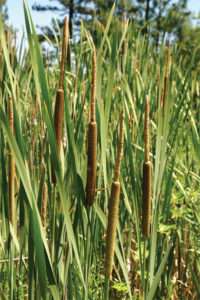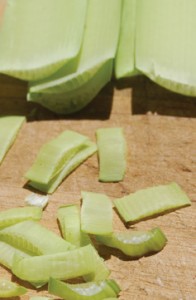Cattail
CATTAIL FAMILY
Broad-leaf Cattail Typha latifolia
Narrow-leaf Cattail Typha angustifolia
Habitat & Elevation Streams and swamps below 6,500′
Collection Leaf, Pollen: summer; Sprouts: spring
Indigenous Names Mountain Maidu bokwopum, bakwapa*
![]()
Broad-leaf Cattail Typha latifolia
Plant type Perennial
Size 6′ – 8’x3′
Light Full sun
Water Regular or standing
Zone 7 to 10
Cattail is an aquatic perennial with an upright habit that grows 6′ – 8′ tall in marshy areas. The flowers, which are dense, cylindrical, reddish-brown spikes appearing at the ends of stems, make good cut flowers. Cattails provide shelter for many forms of wildlife.
Planted at the edge of a pond, cattails will spread quickly to grow into a dense stand. Cut back completely in the fall.[41]
![]()
Cattail Soup
(Raw, Vegan, Gluten-Free)
Collect Cattail Hearts in spring and early summer.
2 cups chopped Cattail Hearts
2 quarts almond milk
2 tbsp fresh ginger
1 shallot
3 cloves garlic
½ bunch fresh wild or garden mint
Juice of 1 lemon
Salt and pepper to taste
Seasonal edible flowers and cattail pollen if available
for garnish
Method
– Purée all ingredients.
– Pour through mesh strainer two times to remove
large cattail fibers.
– Chill for at least 1 hour before serving.
– Garnish with seasonal edible flowers and cattail
pollen if available.
Cattail Corn
- Remove papery outside of green Cattail flower while still in sheaths.
- Bring water to a boil.
- Add Cattail and boil for several minutes.[7, 14]
TIP Enjoy like corn, avoiding the hard inner core.
Cattail Hearts with Fresh Greens
- Slice and serve raw or steam for 10 minutes.
- Serve with seasonal salad greens.
TIP In spring, pull the inner stalks straight up and peel away the outer layers to find the soft, tender hearts (sprouts).
NOTE Cattail hearts are also called “Cossack asparagus.” They provide a good source of beta carotene, niacin, riboflavin, thiamin, potassium, phosphorus and Vitamin C.[7]
Cattail Golden Pollen
- Collect the golden flower pollen by gently shaking the flower heads into a large paper bag.
- Eat raw, sprinkle on salads or mix with other flours for use in baking.[14, 34]
NOTE Cattail pollen is high in minerals and protein.
![]()
Toothache
Rub Cattail jelly, found between the young leaves, on the gums to numb pain.
![]()
Baskets
Soak Cattail for several days and then loosen fibers to weave baskets and mats.








